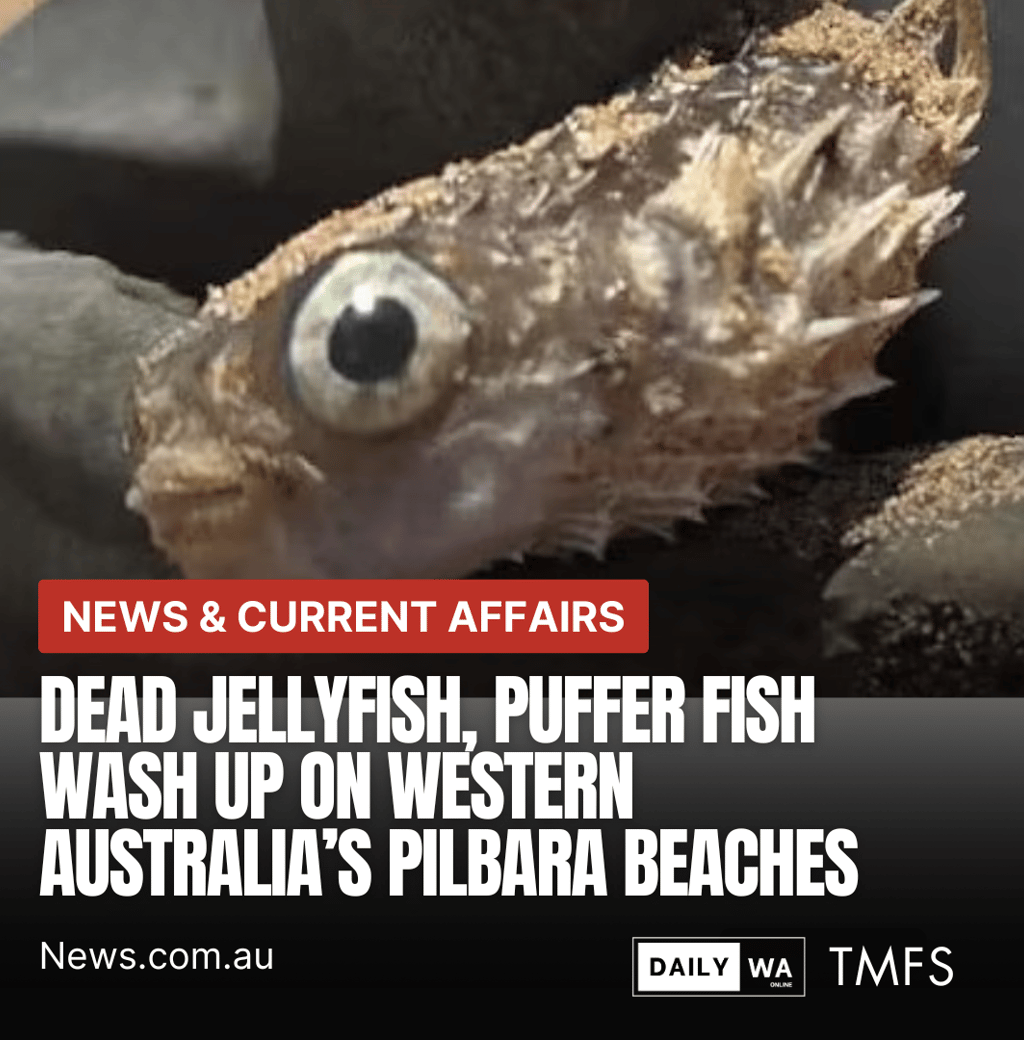Mystery Along the Pilbara Coast: Dead Marine Life Raises Environmental Alarm
Unusual numbers of dead jellyfish and puffer fish have washed ashore along Western Australia’s Pilbara beaches, prompting growing concern from locals and marine scientists about the health of coastal ecosystems.
NEWS & CURRENT AFFAIRS


The turquoise waters of Western Australia’s Pilbara coast are known for their pristine beauty and thriving marine life. But in recent days, this remote shoreline has become the scene of an unsettling mystery. Scores of dead jellyfish and puffer fish have been discovered washed up across popular beaches, sparking alarm among residents and prompting environmental authorities to investigate possible causes.
The incident, first reported by News.com.au, has stirred a wave of concern about the broader ecological health of the Pilbara’s coastal waters. While marine die-offs are not uncommon, the scale and diversity of this event point to deeper environmental stresses that may be unfolding beneath the surface.
As locals shared photos and raised questions online, experts have begun piecing together potential explanations. From water temperature fluctuations and oxygen depletion to toxic algal blooms or chemical runoff, several factors could be converging to create a lethal environment for marine species that are typically resilient to natural variations.
A fragile ecosystem under stress
The Pilbara region is a unique ecological frontier. Its waters support a rich array of species, from coral and sponges to migratory fish and turtles. However, as industrial activity has expanded — particularly in mining, shipping, and coastal development — the region’s marine balance has become increasingly vulnerable.
Scientists have long cautioned that rising sea temperatures and nutrient pollution can disrupt oxygen levels and trigger harmful algal blooms. These blooms often release toxins that affect marine life’s respiratory systems, leading to mass mortality events such as the one now visible along the Pilbara coast.
Dr. Helen McCarthy, a marine biologist who has studied northern Australian ecosystems, noted that even small environmental imbalances can have cascading effects. “When temperature, salinity, and nutrient levels shift suddenly, organisms like jellyfish and puffer fish can be among the first indicators that something is wrong,” she explained in a recent analysis.
Such die-offs act as sentinel events — early warnings of larger ecological problems that, if left unchecked, could impact fisheries, tourism, and local livelihoods.
Community concerns and local response
Local residents have expressed both confusion and sadness at the sight of lifeless marine creatures scattered across once-immaculate sands. Many have urged swift action from environmental agencies to determine whether pollution or runoff may be a factor.
Authorities from the Department of Water and Environmental Regulation (DWER) and Department of Primary Industries and Regional Development (DPIRD) have reportedly begun collecting samples to test for toxins, pathogens, and chemical residues. Preliminary results will help establish whether the cause is natural or anthropogenic — a distinction that carries major implications for environmental management in the region.
Meanwhile, conservation groups have called for greater monitoring of coastal water quality, warning that events like this are becoming more frequent due to climate change and cumulative industrial impacts.
The Pilbara coastline, though often celebrated for its isolation, sits at the intersection of global and local pressures. Warmer ocean currents, shifting monsoon cycles, and resource extraction projects all shape an increasingly complex environmental reality — one that demands proactive stewardship rather than reactive cleanups.
Understanding the bigger picture
To many observers, the recent die-off underscores a broader truth about Australia’s marine future. Even remote coastlines are no longer immune to the combined effects of climate variability, industrial discharge, and ecosystem fragmentation.
The deaths of jellyfish and puffer fish may seem like isolated incidents, but they reflect deeper systemic vulnerabilities. As carbon emissions alter ocean chemistry and local industries expand, the invisible networks that sustain marine life are under unprecedented strain.
Environmental scientists argue that integrated management frameworks — linking data from marine biology, meteorology, and industry — are now essential. Without coordinated monitoring, Australia risks responding to ecological crises only after visible damage has occurred.
A call for awareness and accountability
For the Pilbara, this episode offers both a warning and an opportunity. It reminds communities, policymakers, and industries that economic growth and environmental health are inseparable. Coastal prosperity depends on the resilience of the very ecosystems that now appear to be faltering.
If testing confirms pollution or industrial involvement, the path forward must involve restoration and regulation, not blame alone. And if natural factors are responsible, this should still galvanize efforts to strengthen marine resilience in a warming world.
At TMFS, we believe storytelling plays a vital role in shaping collective awareness. By amplifying moments like this, we highlight the connection between environmental vigilance and community wellbeing. The Pilbara’s story is not just about loss — it is about listening, learning, and leading with responsibility.
As the tides reclaim the shoreline, one truth remains clear: the ocean speaks through its silences and its signals. Our duty is to hear it before it is too late.
All rights belong to their respective owners. This article contains references and insights based on publicly available information and sources. We do not claim ownership over any third-party content mentioned.
